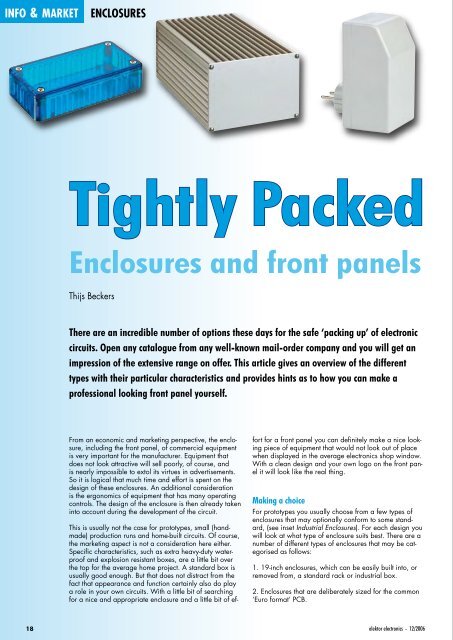Tune that dial - Index of
Tune that dial - Index of
Tune that dial - Index of
You also want an ePaper? Increase the reach of your titles
YUMPU automatically turns print PDFs into web optimized ePapers that Google loves.
info & market enclosures<br />
Tightly Packed<br />
Enclosures and front panels<br />
Thijs Beckers<br />
There are an incredible number <strong>of</strong> options these days for the safe ‘packing up’ <strong>of</strong> electronic<br />
circuits. Open any catalogue from any well-known mail-order company and you will get an<br />
impression <strong>of</strong> the extensive range on <strong>of</strong>fer. This article gives an overview <strong>of</strong> the different<br />
types with their particular characteristics and provides hints as to how you can make a<br />
pr<strong>of</strong>essional looking front panel yourself.<br />
From an economic and marketing perspective, the enclosure,<br />
including the front panel, <strong>of</strong> commercial equipment<br />
is very important for the manufacturer. Equipment <strong>that</strong><br />
does not look attractive will sell poorly, <strong>of</strong> course, and<br />
is nearly impossible to extol its virtues in advertisements.<br />
So it is logical <strong>that</strong> much time and effort is spent on the<br />
design <strong>of</strong> these enclosures. An additional consideration<br />
is the ergonomics <strong>of</strong> equipment <strong>that</strong> has many operating<br />
controls. The design <strong>of</strong> the enclosure is then already taken<br />
into account during the development <strong>of</strong> the circuit.<br />
This is usually not the case for prototypes, small (handmade)<br />
production runs and home-built circuits. Of course,<br />
the marketing aspect is not a consideration here either.<br />
Specific characteristics, such as extra heavy-duty waterpro<strong>of</strong><br />
and explosion resistant boxes, are a little bit over<br />
the top for the average home project. A standard box is<br />
usually good enough. But <strong>that</strong> does not distract from the<br />
fact <strong>that</strong> appearance and function certainly also do play<br />
a role in your own circuits. With a little bit <strong>of</strong> searching<br />
for a nice and appropriate enclosure and a little bit <strong>of</strong> ef-<br />
fort for a front panel you can definitely make a nice looking<br />
piece <strong>of</strong> equipment <strong>that</strong> would not look out <strong>of</strong> place<br />
when displayed in the average electronics shop window.<br />
With a clean design and your own logo on the front panel<br />
it will look like the real thing.<br />
Making a choice<br />
For prototypes you usually choose from a few types <strong>of</strong><br />
enclosures <strong>that</strong> may optionally conform to some standard,<br />
(see inset Industrial Enclosures). For each design you<br />
will look at what type <strong>of</strong> enclosure suits best. There are a<br />
number <strong>of</strong> different types <strong>of</strong> enclosures <strong>that</strong> may be categorised<br />
as follows:<br />
1. 19-inch enclosures, which can be easily built into, or<br />
removed from, a standard rack or industrial box.<br />
2. Enclosures <strong>that</strong> are deliberately sized for the common<br />
‘Euro format’ PCB.<br />
18 elektor electronics - 12/2006

















